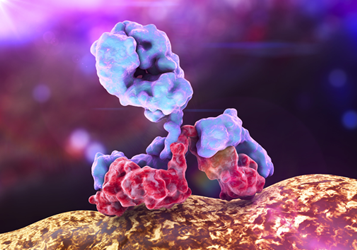- Home
- Products
- Customized ADCs
- EDA
- Anti-EDA (clone F8)-SS-DM1 ADC
Anti-EDA (clone F8)-SS-DM1 ADC (CAT#: ADC-W-399)
This ADC product is comprised of an anti-EDA monoclonal antibody (clone F8) conjugated via a linker to a DM1. The DM1 is targeted to certain cancers by immunerecognition and delivered into cancer cells via receptor mediated endocytosis. Within the cell, DM1 binds to tubulins, interrupts microtubule dynamics, and subsequently, induces cell death.
- Product Information
- ADC Target
- ADC Antibody
- ADC Linker
- ADC payload drug
- Antibody clone #
- F8
- Name
- EDA
- Alternative Names
- EDA; ectodysplasin A; ED1; HED; EDA1; EDA2; HED1; ODT1; XHED; ECTD1; XLHED; ED1-A1; ED1-A2; EDA-A1; EDA-A2; STHAGX1; ectodysplasin-A; oligodontia 1; X-linked anhidroitic ectodermal dysplasia protein;
- Target Entrez Gene ID
- 1896
- Target UniProt ID
- Q92838
- Overview
- The protein encoded by this gene is a type II membrane protein that can be cleaved by furin to produce a secreted form. The encoded protein, which belongs to the tumor necrosis factor family, acts as a homotrimer and may be involved in cell-cell signaling during the development of ectodermal organs. Defects in this gene are a cause of ectodermal dysplasia, anhidrotic, which is also known as X-linked hypohidrotic ectodermal dysplasia. Several transcript variants encoding many different isoforms have been found for this gene.
- Overview
- Anti-EDA Antibody, clone # F8
- Clone #
- F8
- Species Reactivity
- Human
- Name
- Disulfide-linker
- Name
- DM1 (N2’-Deacetyl-N2’-(3-mercapto-1-oxopropyl)maytansine)
- Description
- Derived from Maytansinoid,a group of cytotoxins structurally similar to rifamycin, geldanamycin, and ansatrienin. The eponymous natural cytotoxic agent maytansine is a 19-member lactam (ansa
macrolide) structure originally isolated from the Ethiopian shrub Maytenus ovatus. Maytansinoids can bind to tubulin at or near the vinblastine-binding site, which interfere the formation of microtubules and depolymerize already formed microtubules, inducing mitotic arrest in the intoxicated cells.
For Research Use Only. NOT FOR CLINICAL USE.
Related Products
- Anti-TNFRSF10B (hTRA-8)-VC-MMAF ADC (CAT#: ADC-W-388)
- Anti-SLC3A2 (clone IGNX)-DBM-MMAF ADC (CAT#: ADC-W-548)
- Anti-CD22 (clone 10F4v1)-Mc-MMAF ADC (CAT#: ADC-W-195)
- Anti-MUC1 (clone huC242)-Sulfo-SPDB-DM4 ADC (CAT#: ADC-W-315)
- Anti-CD3E (Visilizumab)-MC-MMAF ADC (CAT#: ADC-W-844)
- Anti-IL17A (Bimekizumab)-SPDB-DM4 ADC (CAT#: ADC-W-2391)
- Anti-IL13 (Anrukinzumab)-MC-Vc-PAB-MMAE ADC (CAT#: ADC-W-1301)
- Anti-CD74-MC-Vc-PAB-DMEA-(PEG2)-duocarmycin SA ADC (CAT#: ADC-W-2553)
- Anti-IL9 (Enokizumab)-SPDB-DM4 ADC (CAT#: ADC-W-1449)
- Anti-MS4A1 (Epitumomab)-SMCC-DM1 ADC (CAT#: ADC-W-2294)
Published Data
+ Submit Publications

Scientific Resources
Customer Reviews and FAQs
There are currently no Customer reviews or questions for ADC-W-399. Click the button above to contact us or submit your feedback about this product.
Quick Links
Other Products
Same Linker
Same Payload
| CAT# | Product Name | Linker | Payload |
| ADC-W-385 | Anti-TDGF1 (clone huB3F6)-Disulfide-linker-DM4 ADC | Disulfide-linker | DM4 (N2'-Deacetyl-N2'-(4-mercapto-4-methyl-1-oxopentyl)maytansine) |
| CAT# | Product Name | Linker | Payload |
| ADC-W-487 | Anti-CD70-MCC-DM1 ADC | MCC (Maleimidomethyl cyclohexane-1-carboxylate) | DM1 (N2’-Deacetyl-N2’-(3-mercapto-1-oxopropyl)maytansine) |
| ADC-W-496 | Anti-EGFR-SMCC-DM1 ADC | SMCC (N-succinimidyl 4-(Nmaleimidomethyl)cyclohexane-1-carboxylate) | DM1 (N2’-Deacetyl-N2’-(3-mercapto-1-oxopropyl)maytansine) |
| ADC-AA-015 | anti-HIgG(Fc)Fab-N-DM1 ADC | Noncleavable linkers | DM1 (N2’-Deacetyl-N2’-(3-mercapto-1-oxopropyl)maytansine) |
| ADC-AA-008 | anti-HIgG(Fc)-N-DM1 ADC | Noncleavable linkers | DM1 (N2’-Deacetyl-N2’-(3-mercapto-1-oxopropyl)maytansine) |
| ADC-AA-026 | anti-MIgG(Fc)-N-DM1 ADC | Noncleavable linkers | DM1 (N2’-Deacetyl-N2’-(3-mercapto-1-oxopropyl)maytansine) |
Online Inquiry
Welcome! For price inquiries, please feel free to contact us through the form on the left side. We will get back to you as soon as possible.



